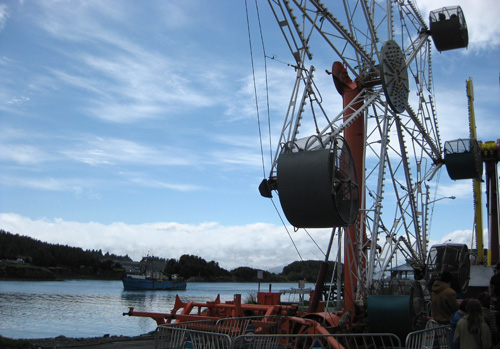Alaska Peninsula

It was a relatively easy passage from Cordova to Kodiak; one week all together, overcast skies, a few lay days due to winds, but the Gulf of Alaska treated us fairly after a few days in Prince William Sound and on the Kenai Peninsula. The Kodiak Crab Festival was in full swing when we arrived, the sun was out, and everyone was having a good time enjoying the carnival rides, survival suit races, and copious food from the vendors. And the seine fleet was making ready for their first opening, repairing nets, provisioning, etc.

The day we left Kodiak, Mark twisted and badly strained his foot, making getting around for him almost impossible. Since the weather forecast for Shelikof Straits was strong SW winds (on our nose), it was decided to go to Long Island (see July 2010) where we knew the anchorage was good in all winds and Nancy could hike around on her own. As noticed on our visit last year, and again this year, there were signs everywhere of cows yet no cows were sited as we hiked. We began to assume that they were phantom cows and came out only at night. But the night before we left, Mark actually spotted cows grazing with a few deer on a small grassy ridge - finally a siting of the phantom cows!


As Mark's foot healed we slowly made our way west, arriving Sand Point a week later. Established by a San Francisco fishing company as a cod station and trading post in 1898, Sand Point is today a thriving town with over 50% of it's permanent residents Aleuts or Unangan. We learned this year that a small buffalo herd is kept on the island.
One of our goals while in the Sand Point area was to pay a visit to Nagai Island and collect rock samples for a UW Geology alumni friend of Nancy's who is planning on doing some work in the area next summer. A weather window opened up and we made a quick trip and successfully collected samples which Nancy then sent via US Post (if it fits it ships!-even rocks) to New York state. We've been asked to also collect samples from Sanak Island which is a little more difficult since it's really out on the edge of things, and the anchorages are only good in fair weather. We'll attempt a stopover at Sanak on our return trip from the Bering Sea.

Cannery workers in many of Alaska's seafood plants, in the recent past, were mostly Philippinos and Mexicans with a few US college students thrown in. In the earlier days, Chinese, Japanese, Irish and Italian. Things continue to change, as has the world. Last year, while we were in Kodiak, there was a local controversy concerning a group of Turkish students that were contracted to come and work. When they arrived, they found that there was no housing available to them and people in town were trying to find places for them to stay. All in all it was not a good deal for the students.
While in Sand Point, Nancy had a long conversation with a Chicano cannery worker who said that most of the workers at the Trident Cannery in Sand Point now are students from places like Uzbekistan, Turkmenistan, and other ex-Soviet states. Nancy met three students from Mongolia while at the internet cafe. They reported that they pay an agent $3,000 to $4,000 dollars to come over and work. The agent arranges their visa, transportation and employment. The average wage is $8 per hour so the workers must work over 400 hours just to break even and all within a three month period. However most work sixteen hour days, so the over-time mounts quickly. They also strive to improve their English during their time in the U.S. Their motivation is extraordinary.
We're currently in King Cove, the last good harbor before False Pass, through which we will pass north from the North Pacific into the Bering Sea. Captain Cook, on his exploration of the region, thought that the pass did not truly connect the two oceans, hence the name that he bestowed. But he was wrong, and for many years the fleet has used False Pass on it's way to and from the Bering Sea crab grounds, or the Bristol Bay salmon fishery.

King Cove got it's name from a trapper and fur trader named King who ran a trading post late in the 19th century and prior to the opening of a cannery in the early 1900's. King Cove exists primarily because of the Peter Pan Seafoods cannery that operates year round, processing millions of pounds of salmon, cod, and Bering Sea crab each season. King Cove is younger, while Sand Point is and has long been a native village and trading and fishing outport, but also has two canneries which, like King Cove, are the basis of its economy today.


This will be our last opportunity for internet and provisioning for awhile. The new harbor in King Cove is practically empty, so we had our pick on spots to tie up. Our friend Chuck Molisky, from Port Townsend, who is skippering a tender for Peter Pan Seafoods, stopped by to visit on his way to Bristol Bay. We hope to find him again later in the season somewhere in the Kodiak area, after he moves to that fishery after the important Bristol Bay Sockeye salmon run.

Labels: Alaska Peninsular, King Cov, Kodiak, Long Island_AK, Nagai Island, Sand Point



1 Comments:
Thanks for the update guys. Been showing Adrienne all your different locations on a big map of the world we've got up on the wall just behind our computer.
Thanks for all the pictures.
John, Becca, and Adrienne
Post a Comment
<< Home